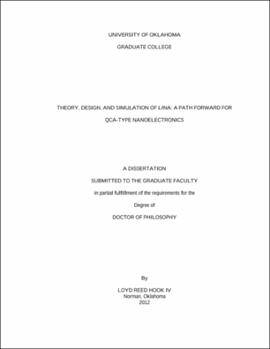| dc.description.abstract | The past 50 years have seen exponential advances in digital integrated circuit technologies which has facilitated an explosion of uses and functionality. Although this rate (generally referred to as "Moore's Law") cannot be sustained indefinitely, significant advances will remain possible even after current technologies reach fundamental limits. However if these further advances are to be realized, nanoelectronics designs must be developed that provide significant improvements over, the currently-utilized, complementary metal-oxide semiconductor (CMOS) transistor based integrated circuits. One promising nanoelectronics paradigm to fulfill this function is Quantum-dot Cellular Automata (QCA). QCA provides the possibility of THz switching, molecular scaling, and provides particular applicability for advanced logical constructs such as reversible logic and systolic arrays within the paradigm. These attributes make QCA an exciting prospect; however, current fabrication technology does not exist which allows for the fabrication of reliable electronic QCA circuits which operate at room-temperature. Furthermore, a plausible path to fabrication of circuitry on the very large scale integration (VLSI) level with QCA does not currently exist. This has caused doubts to the viability of the paradigm and questions to its future as a suitable nanoelectronic replacement to CMOS. In order to resolve these issues, research was conducted into a new design which could utilize key attributes of QCA while also providing a means for near-term fabrication of reliable room-temperature circuits and a path forward for VLSI circuits. | |
| dc.description.abstract | The result of this research, presented in this dissertation, is the Lattice-based Integrated-signal Nanocellular Automata (LINA) nanoelectronics paradigm. LINA designs are based on QCA and provide the same basic functionality as traditional QCA. LINA also retains the key attributes of THz switching, scalability to the molecular level, and ability to utilize advanced logical constructs which are crucial to the QCA proposals. However, LINA designs also provide significant improvements over traditional QCA. For example, the continuous correction of faults, due to LINA's integrated-signal approach, provides reliability improvements to enable room-temperature operation with cells which are potentially up to 20nm and fault tolerance to layout, patterning, stray-charge, and stuck-at-faults. In terms of fabrication, LINA's lattice-based structure allows precise relative placement through the use of self-assembly techniques seen in current nanoparticle research. LINA also allows for large enough wire and logic structures to enable use of widely available photo-lithographical patterning technologies. These aspects of the LINA designs, along with power, timing, and clocking results, have been verified through the use of new and/or modified simulation tools specifically developed for this purpose. To summarize, the LINA designs and results, presented in this dissertation, provide a path to realization of QCA-type VLSI nanoelectronic circuitry. Furthermore, they offer a renewed viability of the paradigm to replace CMOS and advance computing technologies beyond the next decade. | |
